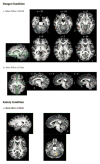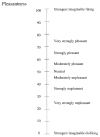Neural correlates of taste and pleasantness evaluation in the metabolic syndrome
- PMID: 25842372
- PMCID: PMC4575285
- DOI: 10.1016/j.brainres.2015.03.034
Neural correlates of taste and pleasantness evaluation in the metabolic syndrome
Abstract
Metabolic syndrome (MetS) is a constellation of cardiometabolic abnormalities that commonly occur together and increase risk for cardiovascular disease and type II diabetes. Having MetS, especially during middle-age, increases the risk for dementia in later life. Abdominal obesity is a central feature of MetS; therefore, increased efforts to prevent obesity and identify predictors of weight gain are of extreme importance. Altered processing of food reward in the brain of obese individuals has been suggested to be a possible mechanism related to overeating. We scanned fifteen healthy middle-aged controls (aged 44-54) and sixteen middle-aged adults with MetS after a fast (hungry) and after a preload (sated), while they rated the pleasantness of sucrose (sweet) and caffeine (bitter) solutions. Data were analyzed using voxelwise linear mixed-effects modeling, and a region of interest analysis to examine associations between hypothalamic activation to sweet taste and BMI during hunger and satiety. The results indicate that middle-aged individuals with MetS respond with significantly less brain activation than controls without MetS during pleasantness evaluation of sweet and bitter tastes in regions involved in sensory and higher-level taste processing. Participants with higher BMI had greater hypothalamic response during pleasantness evaluation of sucrose in the sated condition. Importantly, this study is the first to document differential brain circuitry in middle-aged adults with MetS, a population at risk for poor physical and cognitive outcomes. Future research aimed at better understanding relationships among MetS, obesity, and brain function is warranted to better conceptualize and develop interventions for overeating in these disorders.
Keywords: Aging; Hunger; Metabolic syndrome; Obesity; Reward; Satiety; Taste; fMRI.
Copyright © 2015 Elsevier B.V. All rights reserved.
Figures



Similar articles
-
Age-Related Changes in Gustatory, Homeostatic, Reward, and Memory Processing of Sweet Taste in the Metabolic Syndrome: An fMRI Study.Perception. 2017 Mar-Apr;46(3-4):283-306. doi: 10.1177/0301006616686097. Epub 2017 Jan 6. Perception. 2017. PMID: 28056655
-
Age-related functional changes in gustatory and reward processing regions: An fMRI study.Neuroimage. 2010 Nov 1;53(2):602-10. doi: 10.1016/j.neuroimage.2010.05.012. Epub 2010 May 20. Neuroimage. 2010. PMID: 20472070 Free PMC article.
-
Pleasantness of a sweet taste during hunger and satiety: effects of gender and "sweet tooth".Appetite. 1993 Dec;21(3):247-54. doi: 10.1006/appe.1993.1043. Appetite. 1993. PMID: 8141596
-
Taste, olfactory, and food reward value processing in the brain.Prog Neurobiol. 2015 Apr;127-128:64-90. doi: 10.1016/j.pneurobio.2015.03.002. Epub 2015 Mar 23. Prog Neurobiol. 2015. PMID: 25812933 Review.
-
Hunger and BMI modulate neural responses to sweet stimuli: fMRI meta-analysis.Int J Obes (Lond). 2020 Aug;44(8):1636-1652. doi: 10.1038/s41366-020-0608-5. Epub 2020 Jun 18. Int J Obes (Lond). 2020. PMID: 32555497 Free PMC article. Review.
Cited by
-
Glucose-level dependent brain hypometabolism in type 2 diabetes mellitus and obesity.Eur J Hybrid Imaging. 2021 Feb 17;5(1):3. doi: 10.1186/s41824-021-00097-z. Eur J Hybrid Imaging. 2021. PMID: 34181137 Free PMC article.
-
Sour Promotes Risk-Taking: An Investigation into the Effect of Taste on Risk-Taking Behaviour in Humans.Sci Rep. 2018 Jun 7;8(1):7987. doi: 10.1038/s41598-018-26164-3. Sci Rep. 2018. PMID: 29880852 Free PMC article.
-
fMRI-Based Brain Responses to Quinine and Sucrose Gustatory Stimulation for Nutrition Research in the Minipig Model: A Proof-of-Concept Study.Front Behav Neurosci. 2018 Jul 24;12:151. doi: 10.3389/fnbeh.2018.00151. eCollection 2018. Front Behav Neurosci. 2018. PMID: 30140206 Free PMC article.
-
Differential Effects of BMI on Brain Response to Odor in Olfactory, Reward and Memory Regions: Evidence from fMRI.Nutrients. 2019 Apr 24;11(4):926. doi: 10.3390/nu11040926. Nutrients. 2019. PMID: 31022978 Free PMC article. Clinical Trial.
-
Prolonged latency of the gustatory evoked potentials for sucrose solution in subjects living with obesity compared with normal-weight subjects.Int J Obes (Lond). 2024 Dec;48(12):1720-1727. doi: 10.1038/s41366-024-01607-2. Epub 2024 Aug 25. Int J Obes (Lond). 2024. PMID: 39183345 Clinical Trial.
References
-
- Abbasi F, Brown BW, Jr, Lamendola C, McLaughlin T, Reaven GM. Relationship between obesity, insulin resistance, and coronary heart disease risk. J Am Coll Cardiol. 2002;40:937–43. - PubMed
-
- Alberti KG, Zimmet P, Shaw J. The metabolic syndrome--a new worldwide definition. Lancet. 2005;366:1059–62. - PubMed
-
- Alberti KG, Eckel RH, Grundy SM, Zimmet PZ, Cleeman JI, Donato KA, Fruchart JC, James WP, Loria CM, Smith SC., Jr Harmonizing the metabolic syndrome: a joint interim statement of the International Diabetes Federation Task Force on Epidemiology and Prevention; National Heart, Lung, and Blood Institute; American Heart Association; World Heart Federation; International Atherosclerosis Society; and International Association for the Study of Obesity. Circulation. 2009;120:1640–5. - PubMed
-
- ATP. Third Report of the National Cholesterol Education Program (NCEP) Expert Panel on Detection, Evaluation, and Treatment of High Blood Cholesterol in Adults (Adult Treatment Panel III) final report. Circulation. 2002;106:3143–421. - PubMed
-
- Badre D, D’Esposito M. Functional magnetic resonance imaging evidence for a hierarchical organization of the prefrontal cortex. Journal of Cognitive Neuroscience. 2007;19:2082–2099. - PubMed
Publication types
MeSH terms
Substances
Grants and funding
LinkOut - more resources
Full Text Sources
Other Literature Sources
Medical

